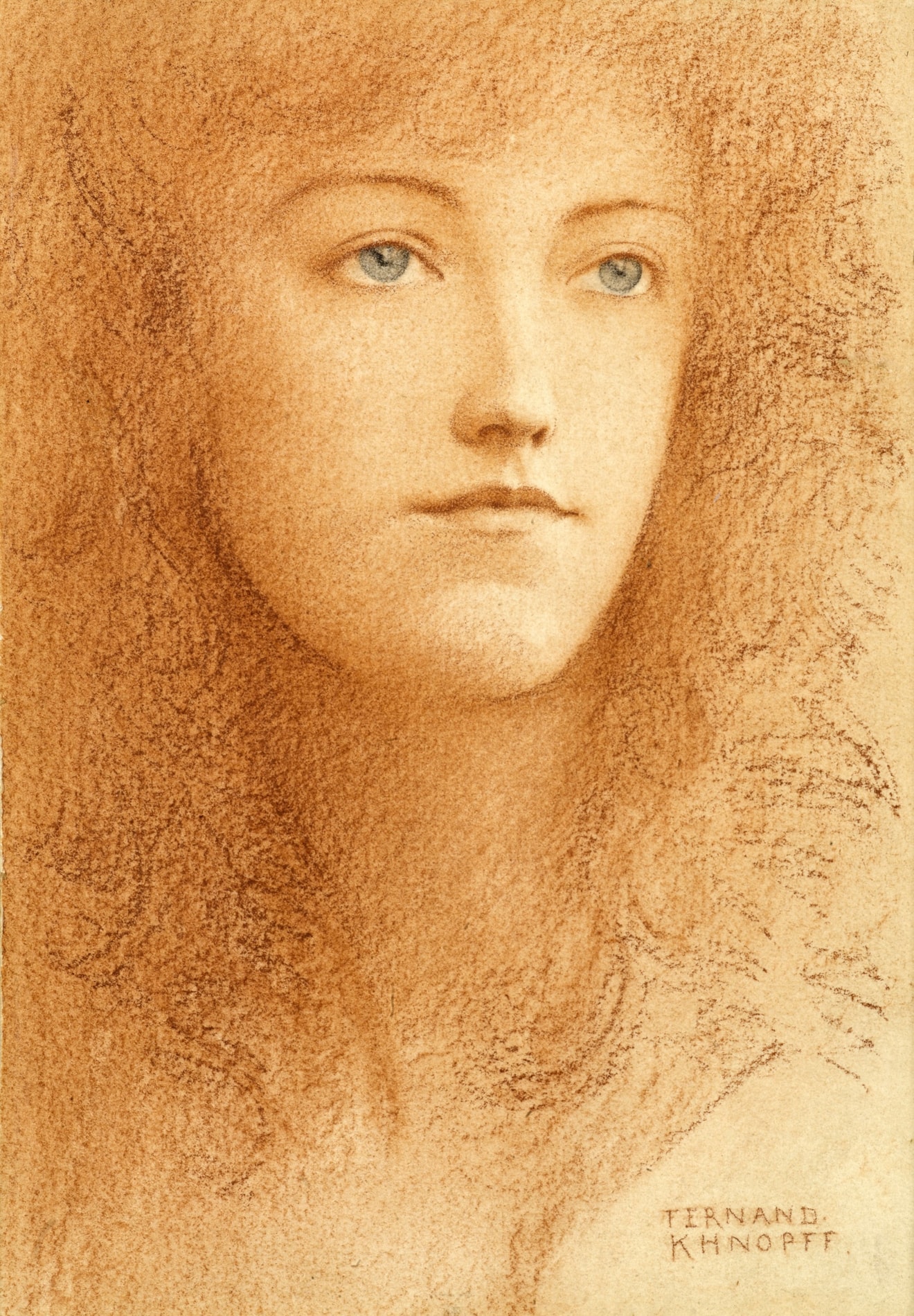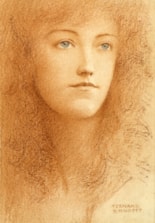Fernand KHNOPFF
(Grembergen-lez-Termonde 1858 - Ixelles 1921)
Étude Anglaise (Portrait of a Young Woman, Probably Elsie Maquet)
Sold
Red chalk with touches of blue chalk, on paper laid down on board.
Signed FERNAND / KHNOPFF at the lower right.
Signed, inscribed and titled Fernand Khnopff / 1 rue St. Bernard / BRUXELLES / étude anglaise. on a label pasted onto the old backing board.
Further inscribed (in a different hand) Donné à cher Françoise / en souvenir de son grand / père. / Avec toute ma tendresse / Grand’ Mère / 12 Nov/82 on the old backing board.
191 x 133 mm. (7 1/2 x 5 1/4 in.)
Signed FERNAND / KHNOPFF at the lower right.
Signed, inscribed and titled Fernand Khnopff / 1 rue St. Bernard / BRUXELLES / étude anglaise. on a label pasted onto the old backing board.
Further inscribed (in a different hand) Donné à cher Françoise / en souvenir de son grand / père. / Avec toute ma tendresse / Grand’ Mère / 12 Nov/82 on the old backing board.
191 x 133 mm. (7 1/2 x 5 1/4 in.)
Like many of his fellow artists, Fernand Khnopff was something of an Anglophile. He spoke English fluently, and made annual visits to England, beginning in 1891. Long interested in English art and culture, he was an avowed admirer of the Pre-Raphaelites, particularly the work of Rossetti and Burne-Jones. Khnopff often gave English titles to his exhibited paintings, while several other works – paintings, drawings and sculptures - were given such titles as Un profil anglais, Une jeune fille anglaise, Un masque de jeune femme anglais and Une tête de femme anglaise. Khnopff also exhibited frequently in London, notably at the Society of British Pastellists, and regularly contributed essays and reviews to the English journal The Studio between 1894 and 1914.
It was through his familiarity with the British community in Brussels that Khnopff met the Maquet family, who were of Scottish origins and lived in the quartier Léopold of the city. The pale skin, long hair and striking eyes of the three Maquet daughters – Elsie, Lily and Nancy – epitomized the artist’s ideal of feminine beauty. From 1891 onwards, following the marriage of his sister Marguerite the previous year and her subsequent move to Liège, Khnopff often used the three Maquet sisters as models.
The present sheet is likely to be a portrait of Elsie, the eldest Maquet daughter, who was born in Glasgow in 1868. With her long red hair, Elsie Maquet posed for several significant paintings and drawings by Khnopff. These include two works inspired by a poem by the English poet Christina Rossetti; the painting I Lock the Door Upon Myself, today in the Neue Pinakothek in Munich, and the finished pastel drawing Who Shall Deliver Me? in a private collection; both works were completed in 1891. Elsie Maquet also served as the model for the painting A Blue Wing of 1894, today in a private Belgian collection.
A recent addition to the corpus of drawings by Khnopff, this remarkable study may be dated to between 1898 and 1900. (The artist lived with his parents on the rue St. Bernard in Brussels – the address inscribed on the old backing board of this drawing – between 1888 and 1901.) It can be associated with a group of portrait drawings in red chalk made by Khnopff around the turn of the century, in which the medium is handled with a particular delicacy and sensitivity. The faces of the women depicted in these drawings exhibit a trancelike aspect, and in several instances the artist has added touches of blue chalk to emphasize the subject’s eyes. As has been noted of the red chalk drawings of this period, ‘The portraits finished in this technique enchant with their fineness and the musicality of the lines. The facial features of the women appear like gossamer on the paper. The fragility of these faces has something seductive about it.’
It was also at about this time that Khnopff developed a characteristic composition for many of his paintings and drawings of women, in which the model’s head is cut off at the top and sides by the edges of the paper or canvas, or by a framing device, and placed close to the picture plane, so as to focus the viewer’s attention on the face. This emphasis on a woman’s face also suggested a mask - a central motif of Symbolist art – behind which was hidden the true nature of the subject.
Geneviève Monnier’s remarks on Khnopff’s use of pastel and coloured chalks, either separately or in combination, may be seen as particularly apposite in the example of this striking drawing. As she writes, ‘Coloured crayons offered a more precise, more delicate medium, the paler colours calling for a more meticulous treatment, while pastel offered greater intensity in terms of line, colour and grain. In fact, one of the characteristics of Khnopff’s work is this special grainy texture in the colouring medium, obtained without making use of the grain of the paper surface as Seurat did in his drawings. His method resembled pointillism, the pastel strokes just touching the paper. Khnopff’s colour schemes often play on melancholy harmonies of white, grey and mauve. His faces are very pale, almost bloodless; they belong to creatures with reddish hair and strange-coloured eyes (like icy water or crystalline rock), wandering in another world, a world beyond the mirror.’
It was through his familiarity with the British community in Brussels that Khnopff met the Maquet family, who were of Scottish origins and lived in the quartier Léopold of the city. The pale skin, long hair and striking eyes of the three Maquet daughters – Elsie, Lily and Nancy – epitomized the artist’s ideal of feminine beauty. From 1891 onwards, following the marriage of his sister Marguerite the previous year and her subsequent move to Liège, Khnopff often used the three Maquet sisters as models.
The present sheet is likely to be a portrait of Elsie, the eldest Maquet daughter, who was born in Glasgow in 1868. With her long red hair, Elsie Maquet posed for several significant paintings and drawings by Khnopff. These include two works inspired by a poem by the English poet Christina Rossetti; the painting I Lock the Door Upon Myself, today in the Neue Pinakothek in Munich, and the finished pastel drawing Who Shall Deliver Me? in a private collection; both works were completed in 1891. Elsie Maquet also served as the model for the painting A Blue Wing of 1894, today in a private Belgian collection.
A recent addition to the corpus of drawings by Khnopff, this remarkable study may be dated to between 1898 and 1900. (The artist lived with his parents on the rue St. Bernard in Brussels – the address inscribed on the old backing board of this drawing – between 1888 and 1901.) It can be associated with a group of portrait drawings in red chalk made by Khnopff around the turn of the century, in which the medium is handled with a particular delicacy and sensitivity. The faces of the women depicted in these drawings exhibit a trancelike aspect, and in several instances the artist has added touches of blue chalk to emphasize the subject’s eyes. As has been noted of the red chalk drawings of this period, ‘The portraits finished in this technique enchant with their fineness and the musicality of the lines. The facial features of the women appear like gossamer on the paper. The fragility of these faces has something seductive about it.’
It was also at about this time that Khnopff developed a characteristic composition for many of his paintings and drawings of women, in which the model’s head is cut off at the top and sides by the edges of the paper or canvas, or by a framing device, and placed close to the picture plane, so as to focus the viewer’s attention on the face. This emphasis on a woman’s face also suggested a mask - a central motif of Symbolist art – behind which was hidden the true nature of the subject.
Geneviève Monnier’s remarks on Khnopff’s use of pastel and coloured chalks, either separately or in combination, may be seen as particularly apposite in the example of this striking drawing. As she writes, ‘Coloured crayons offered a more precise, more delicate medium, the paler colours calling for a more meticulous treatment, while pastel offered greater intensity in terms of line, colour and grain. In fact, one of the characteristics of Khnopff’s work is this special grainy texture in the colouring medium, obtained without making use of the grain of the paper surface as Seurat did in his drawings. His method resembled pointillism, the pastel strokes just touching the paper. Khnopff’s colour schemes often play on melancholy harmonies of white, grey and mauve. His faces are very pale, almost bloodless; they belong to creatures with reddish hair and strange-coloured eyes (like icy water or crystalline rock), wandering in another world, a world beyond the mirror.’
The foremost Belgian Symbolist painter, and arguably the only one to achieve an international reputation, Fernand-Edmond Khnopff enrolled as a law student at the University of Brussels in 1875. However, inspired by art lessons in the studio of the painter Xavier Mellery, he abandoned his university career and entered the Académie Royale des Beaux-Arts in Brussels, where his fellow students included James Ensor and Jean Delville. At the Paris Exposition Universelle of 1878 he came across the work of Gustave Moreau and Edward Burne-Jones, both of whom were to be particular influences on his own style. Khnopff continued his training in Paris, where he attended classes at the Académie Julian. Like Moreau, Khnopff was drawn to Symbolism in his work as a painter and draughtsman. He first exhibited with the L’Essor circle of artists in Brussels in 1881, and two years later was a founder member of Les XX, a group of avant-garde artists, writers and musicians.
Khnopff soon achieved considerable success as an artist, producing commissioned portraits, decorative panels and book illustrations, as well as finished watercolours, pastels and ink drawings, often imbued with a deeper literary or metaphysical meaning. His favourite model was his younger sister Marguerite, with whom he seems to have been in love, and whose features appear in countless paintings and drawings. Championed by the poet and critic Emile Verhaeren, Khnopff earned a measure of success in France, exhibiting for the first time at the Paris Salon in 1884 and in 1892 at the first Salon de la Rose + Croix. The 1890’s saw the artist at the height of his success, both in Belgium and elsewhere in Europe. He continued to exhibit regularly in Brussels, both with Les XX and with its successor La Libre Esthétique, formed in 1893. Khnopff also showed his work at the Munich Secession from 1894 onwards, and enjoyed a popular and successful exhibition at the Vienna Secession in 1898. From 1900 onwards he devoted his energies to the construction of a large house and studio in Brussels, where he worked in increasing isolation. He continued to write essays and reviews, and also began designing costumes and sets for the Théâtre Royal de la Monnaie in Brussels. Khnopff was admitted to the Académie Royale des Beaux-Arts in Brussels in 1907, but his output declined significantly after the First World War.
Provenance
Private collection
Anonymous sale, London, Sotheby’s, 28 November 1990, lot 43
Tokyo Gallery, Tokyo, Japan
Mr. and Mrs. Nicolas Fayt, Berchem, Belgium
Private collection, Belgium, in 2004
Anonymous sale, London, Sotheby’s, 12 November 2008, lot 206
Anonymous sale, Brussels, Pierre Bergé & Associés, 6 December 2010, lot 288
Private collection, London.
Literature
Frederik Leen, Dominique Marechal and Sophie Van Vliet, ed., Fernand Khnopff (1858-1921), exhibition catalogue, Brussels, Salzburg and Boston, 2004, p.141, fig.70; To be included as No.357 bis in the forthcoming supplement to Fernand Khnopff: Catalogue de l’oeuvre, in preparation by Giselle Ollinger-Zinque.




